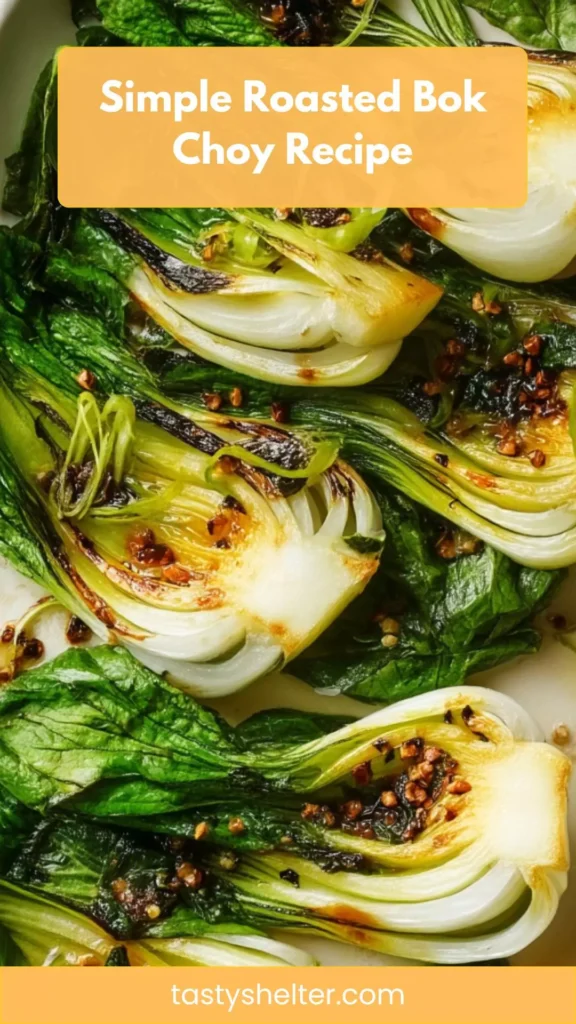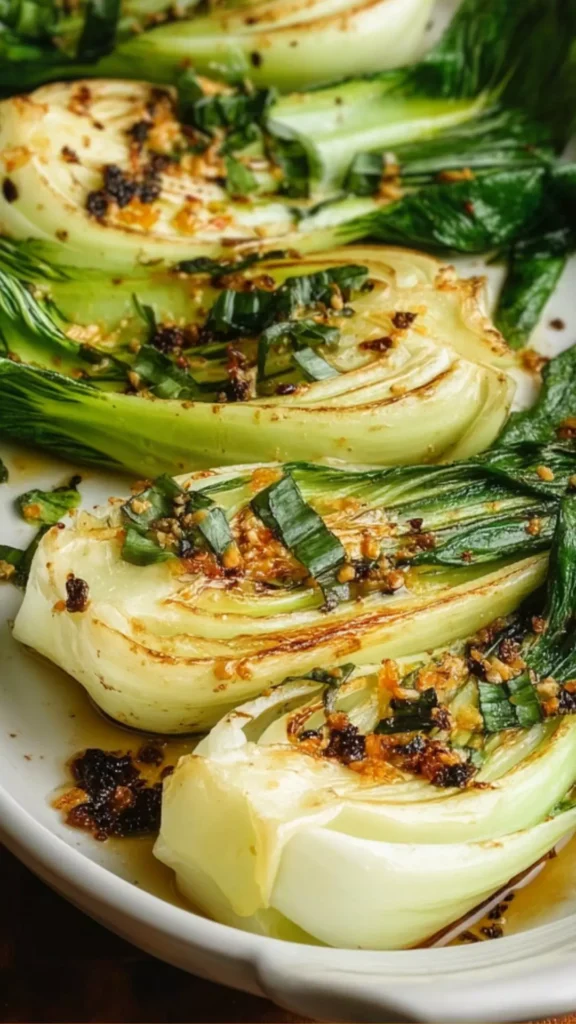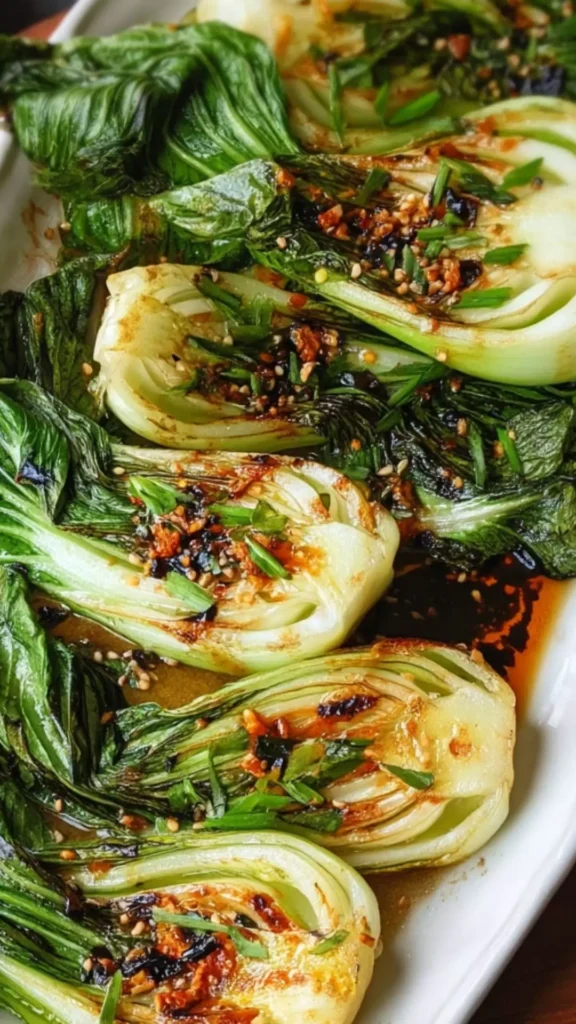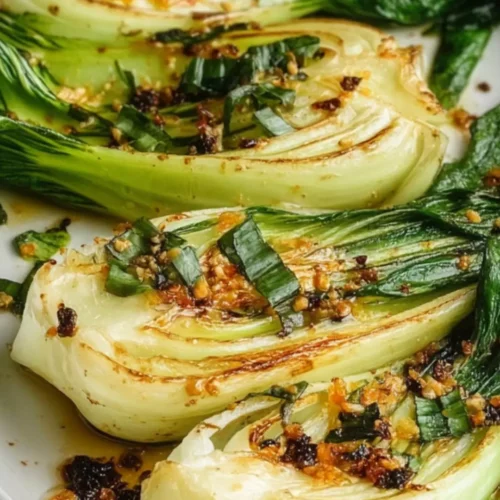Roasted bok choy is a simple yet flavorful vegetable that can enhance a wide range of dishes with its crisp texture and mild, earthy taste. It pairs beautifully with a variety of proteins and grains, making it a versatile addition to your meal.
For a lighter, yet flavorful option, pairing roasted bok choy with fish—especially succulent grilled salmon—creates a delightful contrast, with the richness of the fish balancing the mild flavors of the bok choy. It also pairs wonderfully with chicken, whether you’re serving it alongside a juicy chicken breast or adding it to a more complex dish.
The savory depth of the chicken complements the subtle taste of the roasted bok choy, creating a harmonious balance. Roasted bok choy also makes an excellent addition to rice bowls. Whether you choose brown rice or jasmine rice, adding bok choy and your favorite protein transforms the dish into a wholesome, satisfying meal.
For a more dynamic dish, consider incorporating roasted bok choy into a stir-fry. Combined with other stir-fried vegetables and protein, it creates a hearty and flavorful dish full of varied textures and tastes.

When I first discovered bok choy, I thought, “What an intriguing little vegetable!” With its smooth white stalks and dark green leaves, it’s almost like nature’s own art piece. I would often find myself experimenting with various cooking techniques—steaming, sautéing, you name it.
But nothing captivated my taste buds quite like roasting it. Roasted bok choy not only allows the natural sugars to caramelize, but it also enhances its nutty flavor.
One evening, after a long day, I decided to whip up a quick dinner using some ingredients I had lying around. That’s when I crafted my simple roasted bok choy recipe. It became a mainstay in my kitchen and quickly grabbed the spotlight among my family and friends.
If you’re looking for a simple yet delicious side dish, you’ve come to the right place. Trust me; roasting bok choy is not just easy—it’s incredibly satisfying. Let’s dive into this delightful green.
What Is Simple Roasted Bok Choy?
Simple roasted bok choy is a straightforward yet elegant dish made from the tender leaves and stalks of bok choy. When roasted, it takes on a wonderful texture, becoming slightly crispy on the edges while remaining tender inside.
The roasting process brings out the vegetable’s natural sweetness, making it a perfect side dish for just about any meal.
Why This Recipe Works?
Several factors contribute to the success of roasted bok choy.
- Flavor Enhancement: Roasting caramelizes the natural sugars, enhancing the flavor and creating a slight crunch that contrasts perfectly with the vegetable’s natural tenderness.
- Simplicity: The ingredients are easily accessible and involve minimal preparation. Simply chop, season, and roast.
- Versatility: You can modify this recipe based on what you have on hand. It accommodates various flavor profiles, making it adaptable for numerous cuisines.
- Quick Cooking Time: In about 15-20 minutes, you can have a side dish that not only looks great but tastes even better.
What You’ll Need to Make This Dish
For this simple roasted bok choy, gather the following ingredients:
- 2 Tbsp dark sesame oil
- 1 pound baby bok choy
- 1 Tbsp tamari or low-sodium soy sauce
- 1 Tbsp rice wine vinegar
- 1 tsp lemon juice
- 2 large garlic cloves, finely chopped
- 2 tsp pure maple syrup
- A pinch of freshly cracked black pepper + salt (optional)
- 1/2 tsp ground ginger
- 1 Tbsp chili paste or red pepper flakes
- Garnish: sliced green onions, toasted sesame seeds (either black or white)
These ingredients are mostly pantry staples. The combination creates a balanced flavor profile, ranging from savory to sweet.

How to Make Simple Roasted Bok Choy
Let’s cut to the chase. Baking this dish is easier than a Sunday morning. Here’s a brief snapshot of the steps that will follow.
First, preheat your oven, chop your veggies, and mix your sauces. Then, it’s all about roasting until they become golden and delightful. Simple, right?
Step 1: Preheat the Oven
Begin by preheating your oven to 425°F (220°C). This high heat is key to achieving that lovely caramelization.
Step 2: Prepare the Bok Choy
Wash the baby bok choy thoroughly. Slice each one in half lengthwise to allow the heat to penetrate better. Pat them dry with a kitchen towel. Excess moisture can hinder crisping, so this step is vital.
Step 3: Mix the Sauce
In a bowl, combine the dark sesame oil, tamari or soy sauce, rice wine vinegar, lemon juice, garlic, maple syrup, ground ginger, and chili paste (or red pepper flakes). Mix them well. This mixture is where the magic happens—it brings together all the flavors.
Step 4: Toss the Bok Choy
Place the halved bok choy in a large bowl or on a baking sheet. Drizzle the sauce mixture on top. Toss gently to coat evenly. Make sure every piece is saturated with flavor.
Step 5: Arrange on the Baking Sheet
Lay the bok choy cut-side down on a baking sheet lined with parchment paper. This ensures that they roast evenly and helps with cleanup.
Step 6: Roast
Pop the baking sheet into the preheated oven. Roast for about 15 to 20 minutes. You want the leaves to become slightly crispy and the stalks fork-tender. Keep an eye on them. Ovens vary, and you don’t want them to burn!
Step 7: Garnish and Serve
Once roasted, take the bok choy out of the oven. Sprinkle with sliced green onions and toasted sesame seeds. These garnishes add a pop of color and an extra layer of flavor.
Tips
Here are some suggestions to elevate your roasted bok choy experience:
- Experiment with Flavors: Feel free to swap out ingredients in the sauce. For example, add a dash of sriracha for a spicy kick.
- Batch Cooking: You can roast a larger batch and use leftovers in salads or stir-fries throughout the week.
- Don’t Overcrowd the Pan: If you have too much bok choy, roast in batches to ensure even cooking.
- Add Other Veggies: Carrots, bell peppers, or zucchini can be roasted alongside bok choy for variety.
- Use Fresh Garlic: If possible, use fresh garlic instead of pre-minced for a more robust flavor.
How to Store Leftovers?
Leftover roasted bok choy can be stored in the refrigerator in an airtight container. It will maintain its best quality for about 3-4 days.
When ready to enjoy again, reheat in a skillet over low heat to retain some of that crispy texture.

How Would I Recommend Serving Simple Roasted Bok Choy?
Here are four fantastic serving ideas that highlight roasted bok choy:
- As a Side Dish: Pair it with grilled meats like soy-glazed chicken. The savory, caramelized flavors balance the meat beautifully.
- In a Grain Bowl: Top a bowl of quinoa or brown rice with roasted bok choy, grilled tofu, and a sprinkle of sesame seeds. This makes for a hearty, nutritious meal.
- In Stir-Fried Noodles: Toss cooked noodles with roasted bok choy, sautéed shrimp, and a splash of soy sauce for a colorful, vibrant dish.
- As Part of a Salad: Combine roasted bok choy with fresh greens, sliced cucumbers, and a light vinaigrette. This offers a delightful contrast of warm and cool elements on your plate.
What Alternatives Can You Use for the Ingredients if Not Available?
If you can’t find some of the ingredients, here are four acceptable substitutes:
- Sesame Oil: Olive oil can be a great alternative. While it won’t have the exact flavor profile, it will still work well for roasting.
- Soy Sauce: If you’re gluten-free, coconut aminos is a fantastic swap. It has a similar flavor and is lower in sodium.
- Rice Wine Vinegar: A splash of apple cider vinegar or white vinegar can be used in place of rice wine vinegar for acidity.
- Maple Syrup: If you don’t have access to it, honey or agave syrup can substitute successfully for the same sweetness.

Simple Roasted Bok Choy Recipe
Equipment
- Oven
Ingredients
- 2 Tbsp dark sesame oil
- 1 pound baby bok choy
- 1 Tbsp tamari or low-sodium soy sauce
- 1 Tbsp rice wine vinegar
- 1 tsp lemon juice
- 2 large garlic cloves finely chopped
- 2 tsp pure maple syrup
- A pinch of freshly cracked black pepper + salt optional
- 1/2 tsp ground ginger
- 1 Tbsp chili paste or red pepper flakes
- Garnish: sliced green onions toasted sesame seeds (either black or white)
Instructions
- Begin by preheating your oven to 425°F (220°C). This high heat is key to achieving that lovely caramelization.
- Wash the baby bok choy thoroughly. Slice each one in half lengthwise to allow the heat to penetrate better. Pat them dry with a kitchen towel. Excess moisture can hinder crisping, so this step is vital.
- In a bowl, combine the dark sesame oil, tamari or soy sauce, rice wine vinegar, lemon juice, garlic, maple syrup, ground ginger, and chili paste (or red pepper flakes). Mix them well. This mixture is where the magic happens—it brings together all the flavors.
- Place the halved bok choy in a large bowl or on a baking sheet. Drizzle the sauce mixture on top. Toss gently to coat evenly. Make sure every piece is saturated with flavor.
- Lay the bok choy cut-side down on a baking sheet lined with parchment paper. This ensures that they roast evenly and helps with cleanup.
- Pop the baking sheet into the preheated oven. Roast for about 15 to 20 minutes. You want the leaves to become slightly crispy and the stalks fork-tender. Keep an eye on them. Ovens vary, and you don’t want them to burn!
- Once roasted, take the bok choy out of the oven. Sprinkle with sliced green onions and toasted sesame seeds. These garnishes add a pop of color and an extra layer of flavor.
Notes
- Experiment with Flavors: Feel free to swap out ingredients in the sauce. For example, add a dash of sriracha for a spicy kick.
- Batch Cooking: You can roast a larger batch and use leftovers in salads or stir-fries throughout the week.
- Don’t Overcrowd the Pan: If you have too much bok choy, roast in batches to ensure even cooking.
- Add Other Veggies: Carrots, bell peppers, or zucchini can be roasted alongside bok choy for variety.
- Use Fresh Garlic: If possible, use fresh garlic instead of pre-minced for a more robust flavor.
Nutrition
Frequently Asked Questions
Conclusion
Roasting bok choy is a simple yet effective way to elevate this nutritious vegetable into a delightful side dish. With minimal preparation and few ingredients, you can create a meal that pleases the palate and nourishes the body.
The beautiful caramelization that occurs during roasting brings out sweet, nutty flavors, making it an irresistible addition to any plate.
Experiment with different serving ideas and toppings as you enjoy roasted bok choy time and time again. So, gather your ingredients, preheat your oven, and let the magic happen.
You might just find yourself roasting bok choy every week! Whether you serve it with a hearty protein, toss it into a grain bowl, or simply enjoy it on its own, it’s bound to shine.
Enjoy the flavors and watch your loved ones dig in!




